Stirling Castle, featuring a lesson in rugby and several aphorisms
St. Andrew's Day, celebrating the patron saint of Scotland (the one with the jaunty cross), is for many of us at unis across the country a celebration of the end of our first semester's classes, and the free museum openings and cultural events from the highlands to the lowlands, from Fraserburgh to the Firth of Forth, make this an excellent opportunity to take a break before papers and exams. With exactly that in mind, I booked a Megabus ticket for Stirling (£4 round trip) to take advantage of free entrance to Stirling Castle, about which I knew nothing, other than that Mel Gibson once captured it from the British.After a drive of about an hour and 10 minutes (reading the critic Johannes Voelz on Emerson - I couldn't make a complete escape from Uni) I started off from the Goosecroft bus station below the Thistle Shopping Centre and did my best to find the castle - as always, in Scotland, without a functioning Google Maps. I managed somehow to avoid the charming, busy, shop- and pedestrian-filled "Old Town" and wandered instead into a grimy fogged slum of massage parlors and solicitors of the Saul Goodman variety, and also caught no sight of the castle - a true feat, as this massive hulk of different stone structures thrown up across seven or so centuries occupies the highest point in the town. I was expecting something like the dramatic Edinburgh Castle, visible from just about anywhere. Instead I found a few shuttered pubs and a betting office already open at 11. But I did stumble on a sight that made me catch my breath - at least I'm fairly sure it was this, and not the endless incline of the cobblestone street: the Wallace Monument appeared nobly on a promontory in the valley below, only a few shades darker than the mist-wreathed hills all around it.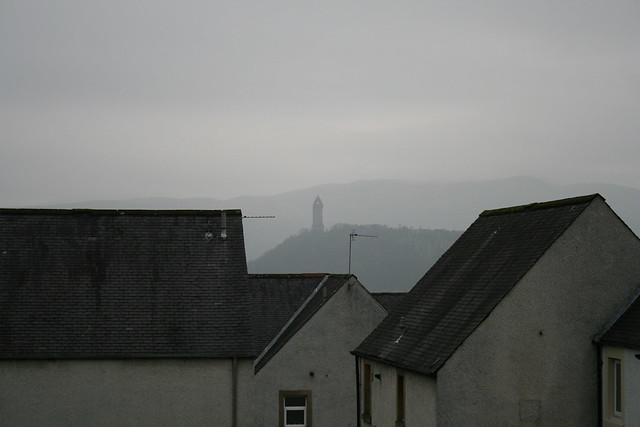 According to legend, William Wallace watched the forces of the English King Edward I amass from his vantage on this volcanic crag. He descended to fight and win the Battle of Stirling Bridge.And all this within sight of the town. All this for the castle I was shortly to visit. Now Stirling took on a new hue.Finally, reasonably sure that the castle was close, I stopped on a bench in the old Mercat Cross, a gathering place for commerce, news, debate, and occasional rioting almost in sight of the castle, to mull things over. The plaza (not really a square) was hung with unlit Christmas lights bearing the names of what I assumed to be the neighborhood children - or else rather vainglorious adults names Rebecca and Jonathan &ct. &ct. From there I perceived Stirling as a city in only the smallest sense of the word - and this wasn't a bad thing. There was something faintly continental about its tiered streets; about the three-story stone structures walling me in; about the plaza - deserted though it was - and something medieval in a manner more of the frontier, of the field, than urban Edinburgh.
According to legend, William Wallace watched the forces of the English King Edward I amass from his vantage on this volcanic crag. He descended to fight and win the Battle of Stirling Bridge.And all this within sight of the town. All this for the castle I was shortly to visit. Now Stirling took on a new hue.Finally, reasonably sure that the castle was close, I stopped on a bench in the old Mercat Cross, a gathering place for commerce, news, debate, and occasional rioting almost in sight of the castle, to mull things over. The plaza (not really a square) was hung with unlit Christmas lights bearing the names of what I assumed to be the neighborhood children - or else rather vainglorious adults names Rebecca and Jonathan &ct. &ct. From there I perceived Stirling as a city in only the smallest sense of the word - and this wasn't a bad thing. There was something faintly continental about its tiered streets; about the three-story stone structures walling me in; about the plaza - deserted though it was - and something medieval in a manner more of the frontier, of the field, than urban Edinburgh.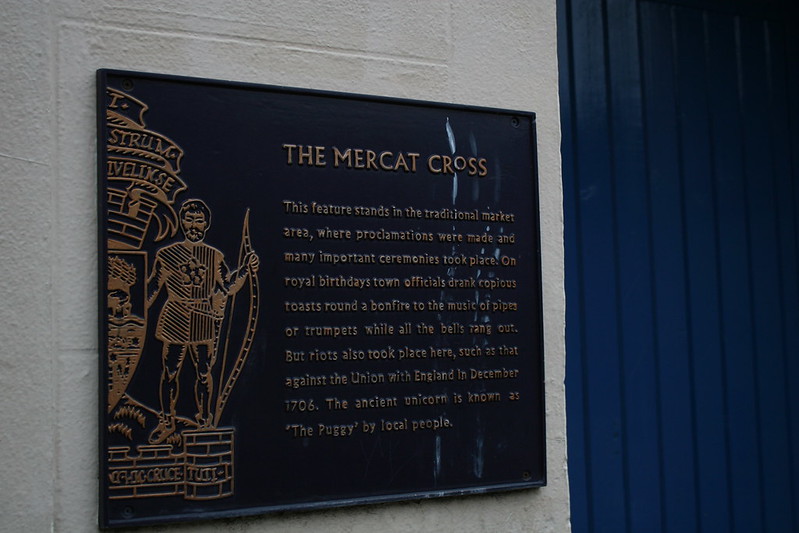
 Stirling CastleThe fortifications were mobbed by gremlinesque invaders shouting in a strange language - and like so many things in Scotland I found the Castle to give more than lip-service to being kid-friendly. So, while I ignored the "Try on a Jester's clothes" exhibit, I got to pass through the palace chambers and halls without fighting much of the crowd, distracted elsewhere.
Stirling CastleThe fortifications were mobbed by gremlinesque invaders shouting in a strange language - and like so many things in Scotland I found the Castle to give more than lip-service to being kid-friendly. So, while I ignored the "Try on a Jester's clothes" exhibit, I got to pass through the palace chambers and halls without fighting much of the crowd, distracted elsewhere.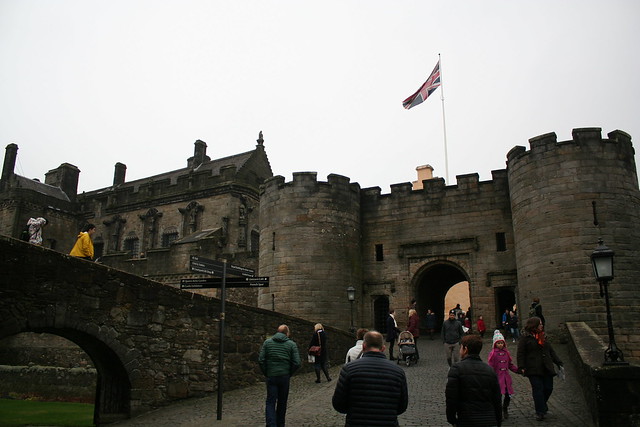 Historic Scotland, the organization behind the slew of free events sweeping the country on St. Andrew's Day, put significant effort into restoring the castle and palace. Repairs to one of the outer walls were ongoing; a new addition behind the old powder storage houses a loom and artists working hard to recreate the castle's "historie of the unicorne" tapestry, the remains of which are currently on display in New York; but the palace rooms, with stand-in furniture and arras, with fake-coffered ceilings, painted with a gesture toward trompe l'oeil almost cartoonish, only brought to mind the Doge's Palace on the Piazza San Marco in Venice - an unfavorable comparison. I remembered the real coffered ceilings, the original tapestries and frescoes, the gold, all too vividly.
Historic Scotland, the organization behind the slew of free events sweeping the country on St. Andrew's Day, put significant effort into restoring the castle and palace. Repairs to one of the outer walls were ongoing; a new addition behind the old powder storage houses a loom and artists working hard to recreate the castle's "historie of the unicorne" tapestry, the remains of which are currently on display in New York; but the palace rooms, with stand-in furniture and arras, with fake-coffered ceilings, painted with a gesture toward trompe l'oeil almost cartoonish, only brought to mind the Doge's Palace on the Piazza San Marco in Venice - an unfavorable comparison. I remembered the real coffered ceilings, the original tapestries and frescoes, the gold, all too vividly.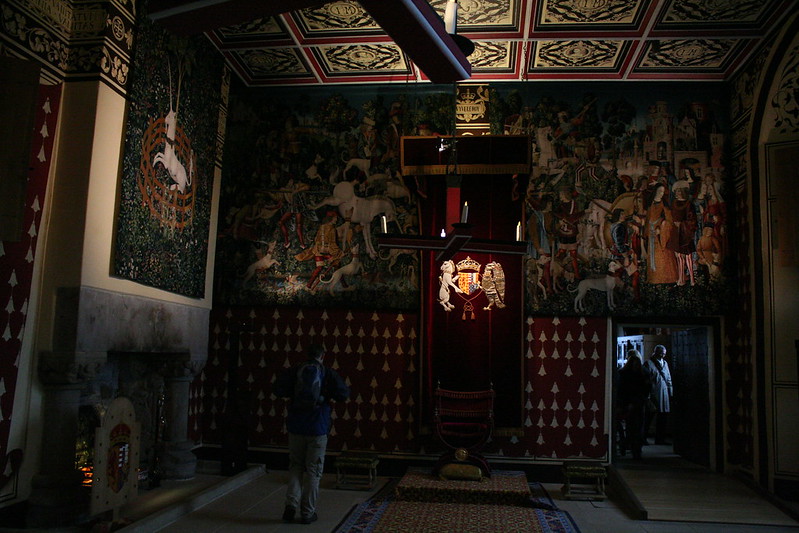 But some of the most impressive treasures of the castle were preserved. The Great Hall (one of the greatest, in its day) is the first part of the castle to draw the eye, with its bright limewashed exterior standing out - pink in the gray fog-filtered light - against the dark, wet, moss-softened mass of the inner palace and fortifications. Inside the great Hall, a recreated hammerbeam ceiling is almost as impressive as the original would have been, and walking the empty floor, one can try to picture the servants rolling in the massive wooden ship, 18 feet long and 40 high, for the christening of Prince Henry in 1594.
But some of the most impressive treasures of the castle were preserved. The Great Hall (one of the greatest, in its day) is the first part of the castle to draw the eye, with its bright limewashed exterior standing out - pink in the gray fog-filtered light - against the dark, wet, moss-softened mass of the inner palace and fortifications. Inside the great Hall, a recreated hammerbeam ceiling is almost as impressive as the original would have been, and walking the empty floor, one can try to picture the servants rolling in the massive wooden ship, 18 feet long and 40 high, for the christening of Prince Henry in 1594.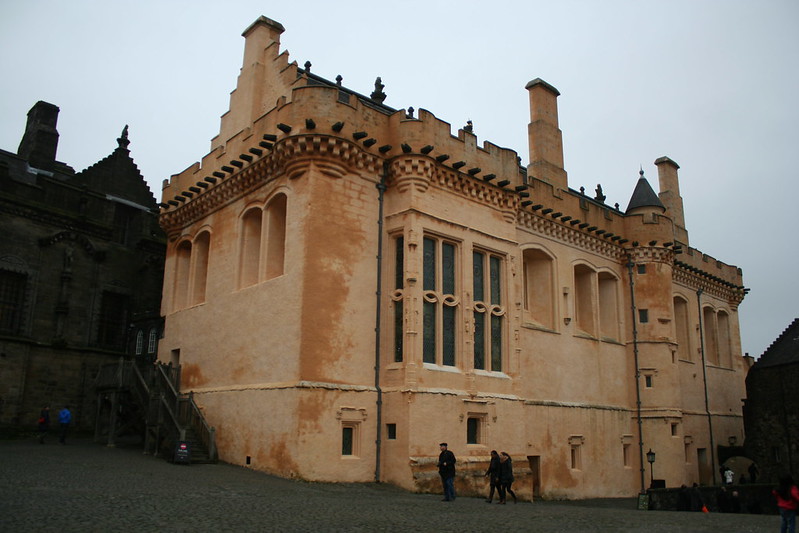 As eye-catching as the palace was, though, I found my thoughts returning to the famed "wooden heads." James V commissioned these hefty oak medallions as part of his image-making in the 1540s. They hung - painted in popping colors to draw out the odd and alluring character of these reliefs - from the ceiling of the palace, and I have to admit that the painted recreations constitute one of the best efforts from the castle's keepers that I saw.
As eye-catching as the palace was, though, I found my thoughts returning to the famed "wooden heads." James V commissioned these hefty oak medallions as part of his image-making in the 1540s. They hung - painted in popping colors to draw out the odd and alluring character of these reliefs - from the ceiling of the palace, and I have to admit that the painted recreations constitute one of the best efforts from the castle's keepers that I saw. Other attractions include the kitchens, worth visiting for the lively (and somewhat disturbing) statues posed through them; the battlements, for dramatic views over the Forth valley (even better, I'm sure, on a clear day); and an odd open square inside the palace, where the kings were supposed to have kept their pet lions. Also worth seeing is a building called Argyll's Lodging, close to the foot of the castle parking lot, and free with your entrance to the above. Considered "the most important surviving Renaissance town-house in Scotland," I found its primary draw to be that it was deserted - I wandered its empty rooms, read about Sir William Alexander (a poet who founded Nova Scotia and died penniless - go figure) and Archibald Campbell, 9th Earl of Argyll, who supported the New Covenanters, escaped from his imprisonment in Edinburgh Castle, but was later beaheaded in the Grassmarket (one of my regular haunts). The recreated rooms are charming, quiet, reflective. They don't harass visitors with blinding plexiglas info panels, and one doesn't have to wait for crowds to get out of the way.
Other attractions include the kitchens, worth visiting for the lively (and somewhat disturbing) statues posed through them; the battlements, for dramatic views over the Forth valley (even better, I'm sure, on a clear day); and an odd open square inside the palace, where the kings were supposed to have kept their pet lions. Also worth seeing is a building called Argyll's Lodging, close to the foot of the castle parking lot, and free with your entrance to the above. Considered "the most important surviving Renaissance town-house in Scotland," I found its primary draw to be that it was deserted - I wandered its empty rooms, read about Sir William Alexander (a poet who founded Nova Scotia and died penniless - go figure) and Archibald Campbell, 9th Earl of Argyll, who supported the New Covenanters, escaped from his imprisonment in Edinburgh Castle, but was later beaheaded in the Grassmarket (one of my regular haunts). The recreated rooms are charming, quiet, reflective. They don't harass visitors with blinding plexiglas info panels, and one doesn't have to wait for crowds to get out of the way.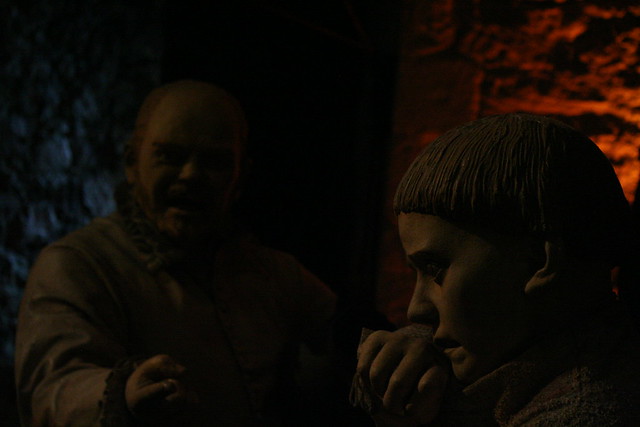 Leaving this, I returned to my Mercat Cross, and "Pudgy" the unicorn, who stands there. But before this, I stole one last look at Stirling Castle. To my right, the Wallace Monument was still erect in the mist. I remembered that William Wallace/Mel Gibson took this place. And I walked away impressed.Old Town: Coffee, and Cold PintI didn't get much farther than Mercat Cross - the Darnley Coffee House, at the bottom, called to me, and I only had to learn, once I espied a small stone marker between the second and third floors, that the building was the nursery of James VI, to convince me to stop for a bite.
Leaving this, I returned to my Mercat Cross, and "Pudgy" the unicorn, who stands there. But before this, I stole one last look at Stirling Castle. To my right, the Wallace Monument was still erect in the mist. I remembered that William Wallace/Mel Gibson took this place. And I walked away impressed.Old Town: Coffee, and Cold PintI didn't get much farther than Mercat Cross - the Darnley Coffee House, at the bottom, called to me, and I only had to learn, once I espied a small stone marker between the second and third floors, that the building was the nursery of James VI, to convince me to stop for a bite.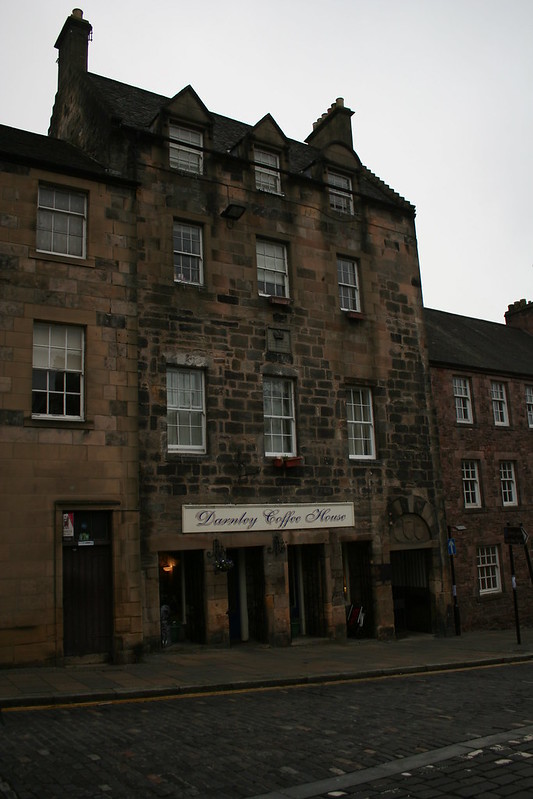 I ordered a cafetière of Old Brown Java (roasted by Thompson's in Glasgow) and a slice of walnut cake for a price refreshingly low after adjusting myself to Edinburgh's market. The order took a wee bit to arrive, but I forgave the two girls running the place - the wait was part of the charm, along with the wind-up children (all drinking "Hot Chocolate - The Works"), the vault-style stone ceiling, the intimacy (you couldn't open the front door without bumping a chair) and the kitchen chatter vaguely reminiscent of a castle's pantries. It gave me a chance to reflect again on the Stirling Heads, which had seemed to converse, on sighting the Wallace Monument, still the emotional high of the day, and to read some more about Emerson (guilt and fear, always the guilt and the fear).(When the cafetière arrived, I wondered when I ought to pour it - and my mind flashed back to Dortmund's southside treasure Café Asemann, where every French press comes with a ticking timer, set based on your choice of roast.)Old Java was what I needed to revive and excite me - spicy overtones, earthy undertones, pleasantly acidic to cut through the caramelly sweetness of the entirely decent cake.Leaving Darnley I found the charming walkable Old Town that I hoped for. Christmas lights criss-crossed the streets and plazas, nothing dazzling like Glasgow's George Square or the LED trees of Edinburgh's George Street. Jewelers, haberdashers, and sweet shop(pe)s were punctuated by coffee nooks while, in the gathering dark but almost primaveral air, secondary school girls sung American blues rock and gypsies played nimble accordion music to boombox backing tracks.
I ordered a cafetière of Old Brown Java (roasted by Thompson's in Glasgow) and a slice of walnut cake for a price refreshingly low after adjusting myself to Edinburgh's market. The order took a wee bit to arrive, but I forgave the two girls running the place - the wait was part of the charm, along with the wind-up children (all drinking "Hot Chocolate - The Works"), the vault-style stone ceiling, the intimacy (you couldn't open the front door without bumping a chair) and the kitchen chatter vaguely reminiscent of a castle's pantries. It gave me a chance to reflect again on the Stirling Heads, which had seemed to converse, on sighting the Wallace Monument, still the emotional high of the day, and to read some more about Emerson (guilt and fear, always the guilt and the fear).(When the cafetière arrived, I wondered when I ought to pour it - and my mind flashed back to Dortmund's southside treasure Café Asemann, where every French press comes with a ticking timer, set based on your choice of roast.)Old Java was what I needed to revive and excite me - spicy overtones, earthy undertones, pleasantly acidic to cut through the caramelly sweetness of the entirely decent cake.Leaving Darnley I found the charming walkable Old Town that I hoped for. Christmas lights criss-crossed the streets and plazas, nothing dazzling like Glasgow's George Square or the LED trees of Edinburgh's George Street. Jewelers, haberdashers, and sweet shop(pe)s were punctuated by coffee nooks while, in the gathering dark but almost primaveral air, secondary school girls sung American blues rock and gypsies played nimble accordion music to boombox backing tracks.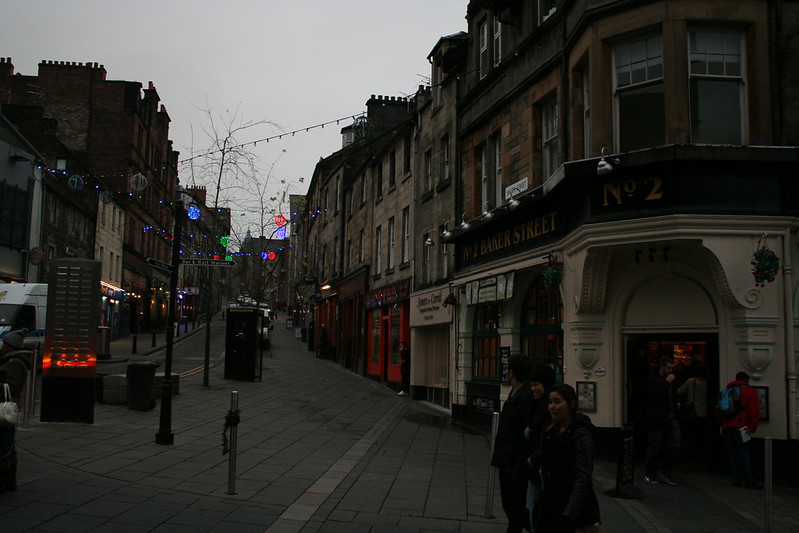 Observations: Cold Beer and RugbyCultivate a taste for beer - good beer and cheap beer both, real ales and the local pisswater - and you become a citizen of the world; you'll find you have earned entrance where no passport could take you. As much as one might want to, one can't go around buying coffee after coffee in every alluring comfortable nook - this only ends in headache and anxiety. But one can stop in to local pub after local pub, and probably find something new to drink in each one - and, beer being one of the more social beverages (especially in contrast to coffee, which the contemporary traveler will drink alone like some angsty Canon-wielding Prufrock), a pint in a new town will likely lead to introductions. Acquaintances of an hour are a pleasure distinct from lifelong friendships, rather than a diminution of the latter - one must learn to jump into them with perfect élan. With limited time, I didn't embark on a Stirling pub crawl, but I did stop at the Cold Beer Company near the station, and watched with about three score other locals a big-screen rugby match between Wales and South Africa.I didn't come to the pub for its name, but it reminded me - "ice cold" beer makes all the difference. I recently disputed this point with Dortmunder pilsner connoisseurs, and won them, with much effort, to my side. Hand-pulled ales have their charm, and hot mulled beers their place, but when it comes to pints in pubs, UK and continental superciliousness have left European imbibers far behind our more refined (and adventurous) American beer tastes. Belhaven's Twisted Thistle (which I've sampled at cellar temperature) was a guest beer here, and I ordered a pint. The chilled temperature brought all the tastes forward, and sharpened them: warm malty body (with a beautiful acorn color) and popping cascade hops. Beside me, three middle-aged Scots pounded back bottles of Budweiser."Cheers," I said (the Swiss Army knife of the Scots vocabulary)."Cheers," they said in return.Meanwhile I learned something about rugby. Fifteen players on each side, most of whom look like more muscular versions of Zach Galifinakis mixed with Chris Farley, form themselves into human-crab-like formations and push at each other on the ground. During this portion the players will habitually pull down each other's shorts, much like the "pantsing" of American elementary school gym class. To prevent this, some members of the same team will actually hold up each other's shorts. I have yet to grasp any but the most obvious tactical advantages to "pantsing" in this game.Unlike in American football, a tackled rugby player will usually get up from an indisputably downed or even supine position and continue running, as if so drunk that he did not notice.Meanwhile, old men dressed like eunuch Bermuda golf club valets from down from plexiglas boxes. The stands are packed with uniformly attractive young women, possibly all because of the Welsh player Dan Biggar, who could have left the field at any moment to star in a new genre of action/cars/rom-com cinema, starting with a series co-written by Nicolas Sparks and Sylvester Stallone.Points are then scored, though I know not how. The Welsh won, but looked sad about it.I left at peace with the fact that my ignorance of rugby would continue through the foreseeable future; but the pint made me almost late for my bus.One should be always almost late for one's buses. The spirit of tourism wanes while the spirit of adventure waxes. I arrived home in Edinburgh in the early evening, the omnipresent mantle of the morning mist exchanged for a fog-medium betrayed only by the city's yellow lights. I may have the chance to visit Stirling again - and when I do, the Wallace Monument and Stirling Bridge will be the first stops I make; the last will undoubtedly be an ale house.
Observations: Cold Beer and RugbyCultivate a taste for beer - good beer and cheap beer both, real ales and the local pisswater - and you become a citizen of the world; you'll find you have earned entrance where no passport could take you. As much as one might want to, one can't go around buying coffee after coffee in every alluring comfortable nook - this only ends in headache and anxiety. But one can stop in to local pub after local pub, and probably find something new to drink in each one - and, beer being one of the more social beverages (especially in contrast to coffee, which the contemporary traveler will drink alone like some angsty Canon-wielding Prufrock), a pint in a new town will likely lead to introductions. Acquaintances of an hour are a pleasure distinct from lifelong friendships, rather than a diminution of the latter - one must learn to jump into them with perfect élan. With limited time, I didn't embark on a Stirling pub crawl, but I did stop at the Cold Beer Company near the station, and watched with about three score other locals a big-screen rugby match between Wales and South Africa.I didn't come to the pub for its name, but it reminded me - "ice cold" beer makes all the difference. I recently disputed this point with Dortmunder pilsner connoisseurs, and won them, with much effort, to my side. Hand-pulled ales have their charm, and hot mulled beers their place, but when it comes to pints in pubs, UK and continental superciliousness have left European imbibers far behind our more refined (and adventurous) American beer tastes. Belhaven's Twisted Thistle (which I've sampled at cellar temperature) was a guest beer here, and I ordered a pint. The chilled temperature brought all the tastes forward, and sharpened them: warm malty body (with a beautiful acorn color) and popping cascade hops. Beside me, three middle-aged Scots pounded back bottles of Budweiser."Cheers," I said (the Swiss Army knife of the Scots vocabulary)."Cheers," they said in return.Meanwhile I learned something about rugby. Fifteen players on each side, most of whom look like more muscular versions of Zach Galifinakis mixed with Chris Farley, form themselves into human-crab-like formations and push at each other on the ground. During this portion the players will habitually pull down each other's shorts, much like the "pantsing" of American elementary school gym class. To prevent this, some members of the same team will actually hold up each other's shorts. I have yet to grasp any but the most obvious tactical advantages to "pantsing" in this game.Unlike in American football, a tackled rugby player will usually get up from an indisputably downed or even supine position and continue running, as if so drunk that he did not notice.Meanwhile, old men dressed like eunuch Bermuda golf club valets from down from plexiglas boxes. The stands are packed with uniformly attractive young women, possibly all because of the Welsh player Dan Biggar, who could have left the field at any moment to star in a new genre of action/cars/rom-com cinema, starting with a series co-written by Nicolas Sparks and Sylvester Stallone.Points are then scored, though I know not how. The Welsh won, but looked sad about it.I left at peace with the fact that my ignorance of rugby would continue through the foreseeable future; but the pint made me almost late for my bus.One should be always almost late for one's buses. The spirit of tourism wanes while the spirit of adventure waxes. I arrived home in Edinburgh in the early evening, the omnipresent mantle of the morning mist exchanged for a fog-medium betrayed only by the city's yellow lights. I may have the chance to visit Stirling again - and when I do, the Wallace Monument and Stirling Bridge will be the first stops I make; the last will undoubtedly be an ale house.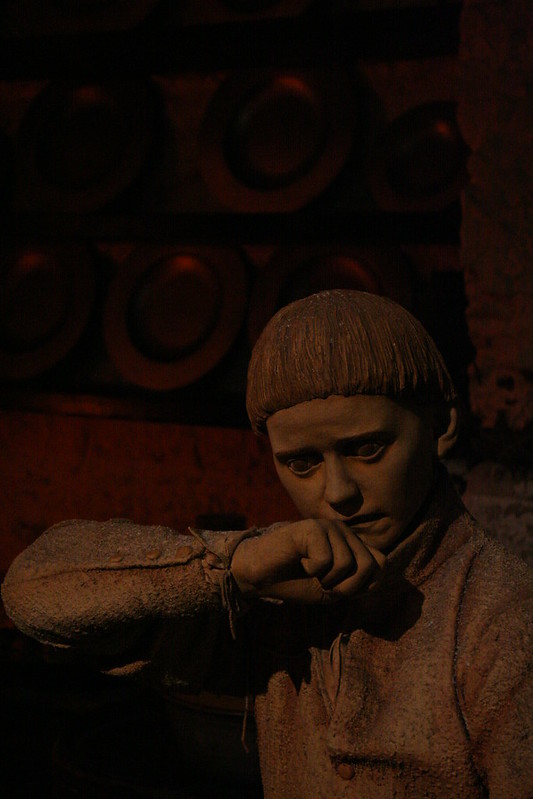 [More pictures]
[More pictures]